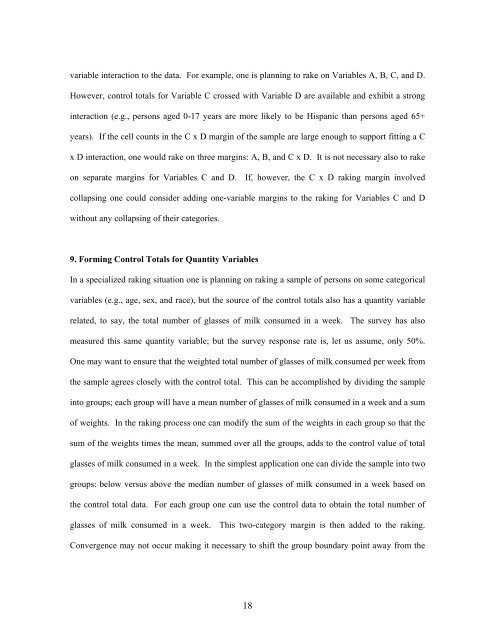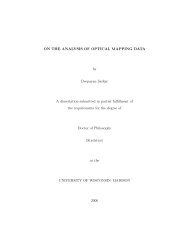Practical Considerations in Raking Survey Data
Practical Considerations in Raking Survey Data
Practical Considerations in Raking Survey Data
You also want an ePaper? Increase the reach of your titles
YUMPU automatically turns print PDFs into web optimized ePapers that Google loves.
variable <strong>in</strong>teraction to the data. For example, one is plann<strong>in</strong>g to rake on Variables A, B, C, and D.<br />
However, control totals for Variable C crossed with Variable D are available and exhibit a strong<br />
<strong>in</strong>teraction (e.g., persons aged 0-17 years are more likely to be Hispanic than persons aged 65+<br />
years). If the cell counts <strong>in</strong> the C x D marg<strong>in</strong> of the sample are large enough to support fitt<strong>in</strong>g a C<br />
x D <strong>in</strong>teraction, one would rake on three marg<strong>in</strong>s: A, B, and C x D. It is not necessary also to rake<br />
on separate marg<strong>in</strong>s for Variables C and D. If, however, the C x D rak<strong>in</strong>g marg<strong>in</strong> <strong>in</strong>volved<br />
collaps<strong>in</strong>g one could consider add<strong>in</strong>g one-variable marg<strong>in</strong>s to the rak<strong>in</strong>g for Variables C and D<br />
without any collaps<strong>in</strong>g of their categories.<br />
9. Form<strong>in</strong>g Control Totals for Quantity Variables<br />
In a specialized rak<strong>in</strong>g situation one is plann<strong>in</strong>g on rak<strong>in</strong>g a sample of persons on some categorical<br />
variables (e.g., age, sex, and race), but the source of the control totals also has a quantity variable<br />
related, to say, the total number of glasses of milk consumed <strong>in</strong> a week. The survey has also<br />
measured this same quantity variable; but the survey response rate is, let us assume, only 50%.<br />
One may want to ensure that the weighted total number of glasses of milk consumed per week from<br />
the sample agrees closely with the control total. This can be accomplished by divid<strong>in</strong>g the sample<br />
<strong>in</strong>to groups; each group will have a mean number of glasses of milk consumed <strong>in</strong> a week and a sum<br />
of weights. In the rak<strong>in</strong>g process one can modify the sum of the weights <strong>in</strong> each group so that the<br />
sum of the weights times the mean, summed over all the groups, adds to the control value of total<br />
glasses of milk consumed <strong>in</strong> a week. In the simplest application one can divide the sample <strong>in</strong>to two<br />
groups: below versus above the median number of glasses of milk consumed <strong>in</strong> a week based on<br />
the control total data. For each group one can use the control data to obta<strong>in</strong> the total number of<br />
glasses of milk consumed <strong>in</strong> a week. This two-category marg<strong>in</strong> is then added to the rak<strong>in</strong>g.<br />
Convergence may not occur mak<strong>in</strong>g it necessary to shift the group boundary po<strong>in</strong>t away from the<br />
18
















